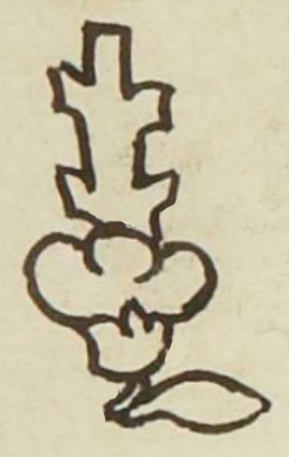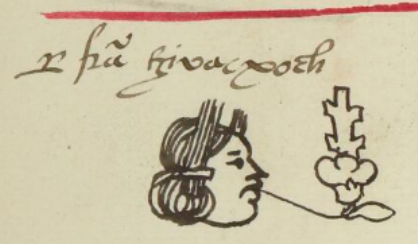Tzihuacxoch (MH546r)
This black-line drawing of the compound glyph for the personal name Tzihuacxoch (“Agave Flower,” attested here as a woman’s name) shows a frontal view of a tree trunk with its branches trimmed. Below the stalk is a flower, also in a frontal view, with three petals, a tripartite sepal, and one horizontal leaf.
Stephanie Wood
In other examples of tzihuactli, below, some have this same look of a small tree trunk with the branches cut off, although one is clearly a cactus. The tree (cuahuitl) seems to provide the phonetic "hua" of tzihuactli.
A metaphorical use of tzihuactli is found in the huehuetlatolli (“elders’ wisdom; words of the elders”) compiled under the leadership of Fray Andrés de Olmos. In the published version’s glossary, an editor’s note tells us that “in the original Nahuatl, tzihuactli, teteihuitl, is a diphrasism that refers to two objects [used in] sacrificial rites.”
Women's names are rare in this tribute list, given that married women contributed to the household tribute, which is recorded under the husband's name. Only widows are recorded separately for their tribute payments.
Stephanie Wood
1560
Jeff Haskett-Wood
flowers, flores, agave, stalks, tallos, spines, espinas

tzihuac(tli), a small agave, https://nahuatl.wired-humanities.org/content/tzihuactli
xochi(tl), flower, https://nahuatl.wired-humanities.org/content/xochitl
La Flor del Agave Pequeño
Stephanie Wood
Matrícula de Huexotzinco, folio 546r, https://www.loc.gov/resource/gdcwdl.wdl_15282/?sp=171&st=image
This manuscript is hosted by the Library of Congress and the World Digital Library; used here with the Creative Commons, “Attribution-NonCommercial-ShareAlike 3.0 License” (CC-BY-NC-SAq 3.0).









